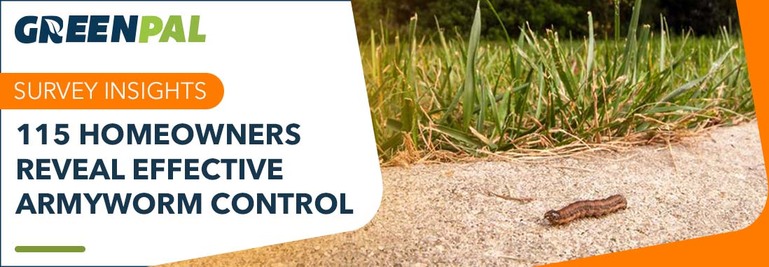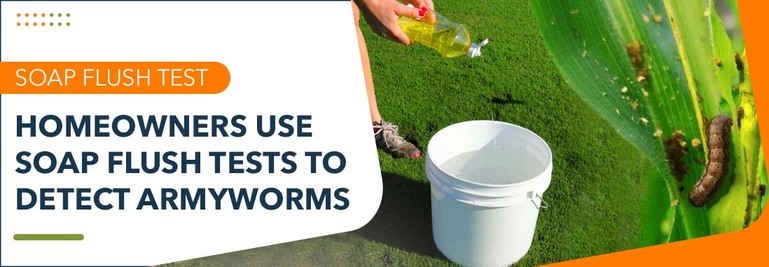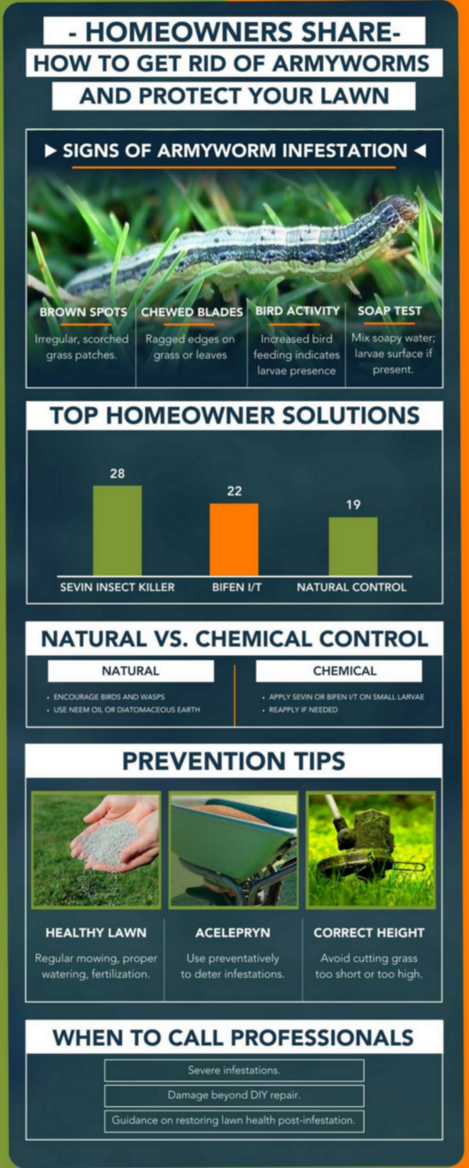Homeowners Share How to Get Rid of Armyworms and Protect Your Lawn

Armyworms are among the most devastating lawn pests that can invade your yard. They strike quickly. An infestation might destroy a lawn in a matter of days. Primarily known as crop pests, armyworms wreak havoc on turfgrasses as well, so we asked 115 homeowners about the products and processes they use to prevent and get rid of armyworms.
As we look into their approaches, we'll share how to recognize, control, and prevent armyworm invasions so you can keep your lawn protected and lush.
Key Results
# Sevin Insect Killer earned the top spot with 28 votes. |
# Bifen I/T took the second spot with 22 votes. |
# 19 homeowners said they rely on birds and predators to take care of armyworms. |

Identifying Armyworm Damage
The first signs of an armyworm infestation include irregular, brown spots in your lawn or sheared to the ground. The larvae's feeding habits create ragged holes in leaves when feeding on corn. Severe feeding might look like hail hit the field of corn.
So, you can imagine how those patterns translate to turfgrass. Grass that's being attacked by armyworms starts to look scorched. Looking closely at these grass blades, you'll notice they are chewed down.
Suppose you notice birds feeding heavily in your yard or increased activity by other predators (notably ground beetles, according to the University of Minnesota Extension). In that case, it might indicate that armyworms are active.
Some other signs include chewing patterns on leaf edges and small, yellowish, or greenish pieces of caterpillar waste on the base of plants.
Life Cycle of Armyworms
You must understand the life cycle of armyworms to control them and prevent them from destroying your lawn. Armyworms have four stages: egg, larva, pupa, and adult moth. Armyworm larvae are the most effective in destroying and eating your beautiful lawn. They must feed voraciously for about two to three weeks.
Types of Army Worms and Where They Come From

Fall armyworms tend to cause the most damage in turfgrasses. A few respondents from Gulf Coast states — particularly Georgia — mentioned encountering armyworms on their lawns.
In Georgia, the fall armyworm moves north from Florida on spring and summer weather fronts. They spread north through the state as several generations complete their life cycles, which is why many homeowners in the Atlanta metropolitan area tend to see armyworms in late summer and early fall.
They are native to tropical regions in the Western Hemisphere. They can be found in every state, but the worst of their infestations are seen more often in states east of the Rocky Mountains.
Some common species include:
|
|
|
|
These pests are migratory. They cannot survive freezing winters but can take advantage of new areas if the weather is right.
How to Get Rid of Armyworms
For many homeowners in our survey with bermudagrass lawns, knowing how to get rid of armyworms is essential. Why bermudagrass? Though it did not provide a direct reason, the Alabama Cooperative Extension noted armyworms "seem to prefer well-fertilized and maintained bermudagrasses." Now, whether there is a correlation to the grass type or it is simply a matter of bermudagrass being a popular choice among homeowners of regions where these pests migrate, it's important to be prepared with some of the following information:

How to Get Rid of Armyworms Organically
One of the best ways to control armyworms is to make space for their predators. Birds, beneficial insects such as parasitic wasps, and some nematodes can all keep armyworm numbers down. Put out bird feeders. Plant flowers that armyworm predators like.
Organic products, like neem oil, which received 8 votes from respondents, can also work. It interferes with the feeding and growth of armyworms and will kill them. You can use neem oil as a preventative, too. You can mix a couple of teaspoons of neem oil with warm water and soap to spray on your lawn now and again to help keep armyworms at bay. Diatomaceous earth, a natural substance made of fossilized algae that have been crushed into a powder, can be sprinkled on the lawn and will discourage pests like armyworms from settling in. It can cut them up and even dry them out.
Using Insecticides
If the infestation is severe, chemical control can be used. Caterpillar-specific insecticides are very effective at controlling armyworms.
It's all about timing. Armyworms are at their most vulnerable when they're small larvae. So treating your lawn with the insecticide early in its life cycle is key – and it must be applied evenly across the lawn, too. A second application may be needed if the armyworms have hatched new larvae. Many of the homeowners in our survey use Sevin Insect Killer and Bifen I/T to get rid of armyworms.
Using the Soap Flush Test for Armyworms
Many homeowners we spoke to mentioned they start with the soap flush test to see if they have an infestation.

You'll need a bucket of water and mix in lemon-scented dish soap — a three tablespoons soap to 1-gallon water ratio works well. The claim is that the soap agitates the caterpillar's skin and brings them to the surface. If you see them come up, you've got an armyworm problem. If not, try again later and try in other areas.
Preventing Future Infestations
Keeping your lawn healthy is one of the best ways to keep armyworms away. Regular mowing, proper watering, and fertilization all contribute to keeping your grass robust and less attractive to pests. Armyworms gravitate toward stressed or unhealthy lawns, so having a healthy lawn will reduce your chances of an infestation.
You must mow your lawn to the right height. Cutting it too short enables armyworms to get to the roots by removing protective soil cover. Mowing it too high allows them to burrow. Find the right height for your grass type and region. A handful of votes stated Acelepryn worked well as a preventative.
Deep watering infrequently encourages deeper root development, which helps lawns deal with armyworm damage better. Overwatering can cause fungal problems, so don't overdo it.
When to Call a Professional for an Infestation
Sometimes, an armyworm outbreak may be too large for DIY treatment, and a lawn care professional may need to be called in to remedy the damage, which can become severe. Professionals have access to stronger treatments and more experience in controlling heavy infestations.
An expert can also advise on how to correct the lawn after the infestation, including whether to overseed or put down new sod.
Frequently Asked Questions About Armyworms

How long do armyworms stay active?
The larval stage of armyworms typically lasts only two to three weeks, but in a single season, there can be multiple generations, so they can be active for months.
Can armyworms damage other plants?
Indeed, armyworms will feed on many plants and crops, especially vegetable gardens and ornamental plants.
What should I do if my neighbor has an armyworm infestation?
If your neighbor has armyworm infestation, act quickly to prevent the problem from spreading to your yard. Step up monitoring, use a preventative insecticide if necessary, and make sure your lawn is in good condition so it will be less likely to become a breeding ground for armyworms.

Quick Summary
Aspect | Details |
Survey Insights | In a survey of 115 homeowners, Sevin Insect Killer was the most popular choice with 28 votes, followed by Bifen I/T with 22 votes. 19 homeowners relied on birds and predators. |
Signs and Life Cycle of Armyworms | Look for irregular brown patches, scorched grass, and chewed blades. Armyworms go through four stages: egg, larva (most destructive), pupa, and adult moth. |
Natural vs. Chemical Control | Natural: Encourage predators (birds, beneficial insects), use neem oil (8 votes) or diatomaceous earth. Chemical: Sevin and Bifen I/T for early larvae. |
Detection Methods | Use the soap flush test (soapy water mix) to bring larvae to the surface and confirm infestation. |
Prevention Tips | Maintain a healthy lawn: regular mowing, deep watering, proper fertilization, and consider using Acelepryn (few votes) for prevention. |
When to Act or Call a Professional | Early intervention is crucial. Call a professional for large infestations, severe damage, or to restore your lawn post-infestation. |
Armyworm control can be difficult, but with the right knowledge and tools, you can protect your lawn and keep it lush and green. Learning the armyworm life cycle, knowing the signs of an armyworm infestation, and applying natural and chemical control methods can help you eliminate armyworms from your lawn. Staying vigilant about overall lawn maintenance and overseeding can also prevent future infestations.
Remember, the best defense against armyworms is proactive care and early intervention. Do not wait until the damage has been done. Protect your lawn from armyworm damage today with good lawn care practices.



 Share
Share










